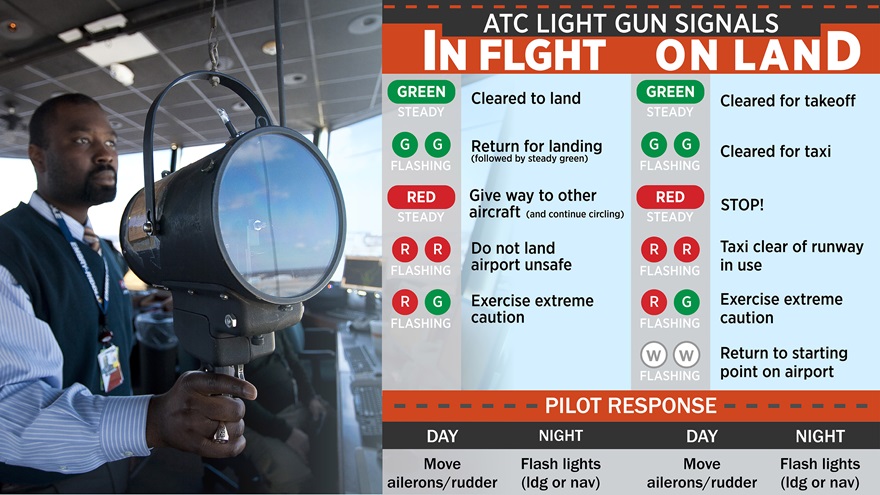Light Gun Signals
Visual light gun signals are provided to the pilot when no radio is equipped on the aircraft or during communication malfunctions.
Introduction
Introduction
- Light gun signals are a tool used by Air Traffic Control Towers (ATCT) when:
- No radio is equipped on the aircraft
- Communications cannot be established, or
- During communication malfunctions [Figure 1]
- Applies not only to aircraft, but to ground vehicles, equipment, and personnel not equipped with radios
- ATC personnel use a directive traffic control signal which emits an intense narrow light beam of a selected color (either red, white, or green) when controlling traffic by light signals
Light Gun Procedures
Light Gun Procedures
- If radios go out in the terminal area, circle the field and wait for light gun signals
- If no signals appear evident after a sufficient amount of time waiting, begin an approach when traffic has been determined and de-conflicted and land on the active runway (as dictated by traffic and wind) and look for light gun signals
- If in the pattern and no light gun signals are observed, wave-off your first approach and continue in the pattern for a full stop
- If radio malfunction occurs after departing the parking area, watching the tower for light signals or monitor tower frequency
-
Day Light Gun Procedures:
- Rock your wings to get towers attention and acknowledge towers instructions or light signals by moving the ailerons or rudder
-
Night Light Gun Procedures:
- At night, acknowledge by blinking the landing or navigation lights
- Between sunset and sunrise, a pilot wishing to attract the attention of the control tower should turn on a landing light and taxi the aircraft into a position, clear of the active runway, so that light is visible to the tower
- The landing light should remain on until appropriate signals are received from the tower
Notes
Notes
- A green light means you are cleared to land on any runway
- Signals can be difficult to see during the day, especially if you're trying to fly and look at the tower [Video 1]
- At night, light signals as you can imagine are easy to see, but from towers point of view, you may not
- Complicating matters, if you have an electrical issue causing your inability to communicate, you may not have working lights either
- Disadvantages:
- Pilots may not be looking at the control tower at the time a signal is directed toward their aircraft
- The directions transmitted by a light signal are very limited since only approval or disapproval of a pilot's anticipated actions may be transmitted
- No supplement or explanatory information may be transmitted except by the use of the "General Warning Signal" which advises the pilot to be on alert
Private Pilot (Airplane) Communications, Light Signals, and Runway Lighting Systems Airman Certification Standards
Private Pilot (Airplane) Communications, Light Signals, and Runway Lighting Systems Airman Certification Standards
- Objective: To determine whether the applicant exhibits satisfactory knowledge, risk management, and skills associated with normal and emergency radio communications, air traffic control (ATC) light signals, and runway lighting systems
- References: 14 CFR part 91; FAA-H-8083-2 (Risk Management Handbook), FAA-H-8083-25 (Pilot Handbook of Aeronautical Knowledge); AIM
- Private Pilot (Airplane) Communications, Light Signals, and Runway Lighting Systems Lesson Plan
Private Pilot (Airplane) Communications, Light Signals, and Runway Lighting Systems Knowledge:
The applicant demonstrates an understanding of:-
PA.III.A.K1:
How to obtain appropriate radio frequencies. -
PA.III.A.K2:
Proper radio communication procedures and air traffic control (ATC) phraseology. -
PA.III.A.K3:
ATC light signal recognition. -
PA.III.A.K4:
Appropriate use of transponders. -
PA.III.A.K5:
Lost communication procedures. -
PA.III.A.K6:
Equipment issues that could cause loss of communication. -
PA.III.A.K7:
Radar assistance. -
PA.III.A.K8:
National Transportation Safety Board (NTSB) accident/incident reporting. -
PA.III.A.K9:
Runway Status Lighting Systems.
Private Pilot (Airplane) Communications, Light Signals, and Runway Lighting Systems Risk Management:
The applicant is able to identify, assess, and mitigate risks associated with:-
PA.III.A.R1:
Communication. -
PA.III.A.R2:
Deciding if and when to declare an emergency. -
PA.III.A.R3:
[Archived]. -
PA.III.A.R4:
Use of non-standard phraseology.
Private Pilot (Airplane) Communications, Light Signals, and Runway Lighting Systems Skills:
The applicant exhibits the skills to:-
PA.III.A.S1:
Select and activate appropriate frequencies. -
PA.III.A.S2:
Transmit using standard phraseology and procedures as specified in the Aeronautical Information Manual (AIM) and Pilot/Controller Glossary. -
PA.III.A.S3:
Acknowledge radio communications and comply with ATC instructions or as directed by the evaluator.
Conclusion
Conclusion
- Although the traffic signal light offers the advantage that some control may be exercised over nonradio equipped aircraft, pilots should be cognizant of the disadvantages
- Still looking for something? Continue searching:
References
References
- Federal Aviation Administration - Pilot/Controller Glossary
- Aeronautical Information Manual (4-3-13) Traffic Control Light Signals
- CFI Notebook.net - Air Traffic Control Tower (ATCT)
- CFI Notebook.net - Emergency Voice Reports
- Federal Aviation Regulations (91.125) ATC light signals
- Professional Helicopter Pilots Association
